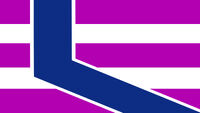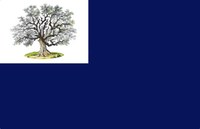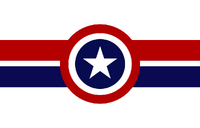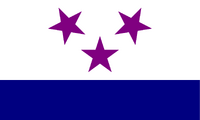The flag of the state of Connecticut consists of a white baroque shield with three grapevines (each bearing three bunches of purple grapes) on a field of azure blue. The banner below the shield reads "Qui Transtulit Sustinet" ("He who transplanted still sustains"), the state's motto.
Shown below are various designs for a proposed new flag of Connecticut.
In the style of the New England flag and with a purple base to represent the grapevines in the original CT flag. The unofficial nickname of the state is the Nutmeg State which is represented by the nutmeg seed in the canton, borrowed from the nutmeg on the flag of Grenada
Connecticut flag proposal by Zolntsa
This proposal features a St. George's Cross inspired Connecticut Cross (Perhaps a 'McGivney' Cross in honor of the CT native who founded the Knights of Columbus) that recognizes the state's early history --but colored purple so as to assert the state's modern sovereignty and proud separation from foreign rule.
CT Flag Proposal "Vexilo"
CT Flag Proposal "vexilo - ammended by Tibbetts"
CT Flag Proposal "luketheduke03 1"
CT Flag Proposal "luketheduke03 2"
CT Flag Proposal "Bezbojnicul"
CT Flag Proposal "Edward O'Connor"
CT Flag Proposal "ironchefshark"
CT Flag Proposal "VoronX 1"
CT Flag Proposal "VoronX 2"
CT Proposed Flag "VoronX 3"
CT Proposed Flag "VoronX 4"
CT Proposed Flag "Rotterdam Herald"
CT Proposed Flag "Jack Expo 1"
CT Proposed Flag "Jack Expo 2"
CT Flag Proposal "FlagFreak"
CT Flag Proposal "Tibbetts"
CT Flag Proposal "Graphicology"
CT Flag Proposal "VT45 1"
CT Flag Proposal "VT45 2"
CT Flag Proposal "AlternateUniverseDesigns"
CT Flag Proposal "Usacelt"
CT Flag Proposal by Kermitdefrog
Connecticute State Flag Proposal No. 2 Designed By: Stephen Richard Barlow 15 AuG 2014
CT Flag Proposal "Ben Karnell"
CT Flag Proposal "BigRed618"
Connecticut State Flag Symplistic Proposal. I noticed the red-white-red stripes for the flag because they are commonly used on most of the state’s branding, including their official website. I kept the grapevine from the existing flag and seal, because it was an early symbol of prosperity and is believed to represent early individual. By Ed Mitchell. 2013.
Connecticut State Flag Proposal No. 7 Designed By: Stephen Richard Barlow 06 MAY 2015 at 1031 HRS CST.
Connecticut flag proposal by Arminius13
CT flag proposal "5thEye"
Connecticut Flag Proposal by Enterprise09
Connecticut Flag Proposal by TheMaster001
Connecticut state flag proposal by James Dignan, September 2014, based on the arms of the Say and Sele family
Green star stands for the charter Oak. The purple for the vines. The blue for the Ocean. The 5 stripes for the order of admission. The white for the constitution. Design by Rotten Ali.
Connecticut state flag proposed by Ken Morton - This is my tweak of an excellent design by Ben Karnell. Mr. Karnell's substitution of the "Charter Oak" for grapes/grape vines as the state's representational symbol is a welcome design improvement.
As a unifying design principle, I believe the flags of the original thirteen states should, when possible, incorporate thirteen stars. Above is my proposed design for a new flag for my home state. [Posted by Ken Morton]
Yet another 'Charter Oak' flag. This design builds upon earlier submissions by multiple users. [Posted by Ken Morton]
Grapevines in the canton with five purple and white stripes to represent Connecticut's admission as fifth state to the United States.
275 designs were studied and voted on. These were the final 6 designs. Most either had the Oakland City tree or vine plants from the State Seal. Winner was well supported.
Connecticut state flag proposed by Ken Morton [June 26, 2019] I like this one.
Yet another state flag for Connecticut. Really, anything would be better than our current flag. [Borrowed the grapes from "Bezbojnicul".] Posted by Ken Morton
Inspired by a design by "Sammy" [see above]. Posted by Ken Morton.
He who is transplanted, is sustained. [My home state] Posted by Ken Morton
The blue vertical line represents the Connecticut River (the longest in New England) cutting across the state, The three purple lines represent the grapevines in the state seal dating from 1635, as well as the original three colonial districts which united to form the state: Windsor, Wethersfield, and Hartford. The green bars run between the purple District bars and across the River bar, symbolizing the significance of the Charter Oak, which both helped unify and establish the state. The white backdrop represents the paper on which the US Constitution was written and the state’s nickname “Constitution State.” Posted by Preston Knapp
[1]CT Flag Proposal "apollohawkridge 1"
CT Flag Proposal "apollohawkridge 2"
Proposed flag for Connecticut. The off-center cross of Saint George represents Connecticut's beginnings as an English colony. The thirteen stars symbolize Connecticut's status as one of the original thirteen states. (Posted by Ken Morton)
Alternate version of previous design. (Posted by Ken Morton)
Proposal "three grapes" for a flag for the state of Connecticut. By
Qaz Dec 2019 (
details)
The green and purple represent the leaves and the fruit of the grape vines on the current american flag. The grapes in white represent the grapes again. The 3 stripes represent the 3 individual vines on the original flag.
The 3 purple stripes represent the 3 grape vines on the original flag. The blue bent stripe represents the flow of the Connecticut River
An alternately colored version of previous flags
A flag partially inspired from other submissions, and from our neighbors in Rhode Island.
A Charter Oak flag, with the oak design borrowed from Connecticut's commemorative state quarter. (Posted by Ken Morton)
Another Charter Oak design. (Posted by Ken Morton)
An abstract design. A good fit for a state without a widely recognized representational symbol (Posted by Ken Morton)
Thirteen stars and an oak leaf cluster, representing the Charter Oak. The three oak leaves mirror the three grape vines on the current Connecticut flag and , like the vines, symbolize the three original colonies -- the Hartford, New Haven and Saybrook colonies -- that were combined to form the colony of Connecticut.(Posted by Ken Morton)
Adding 5 Shards in a Star, Charter Oak Tree, Nutmeg, and St George Cross
Connecticut Flag Proposal- first made in March 2021 by
Rebecca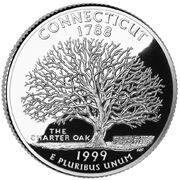















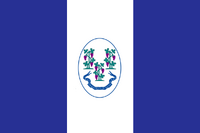



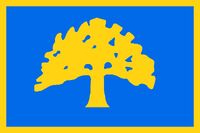
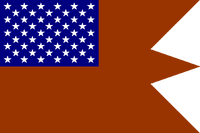




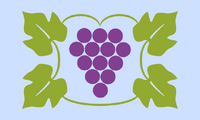









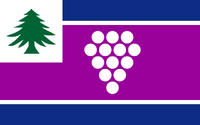
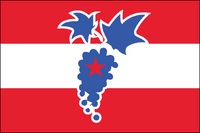

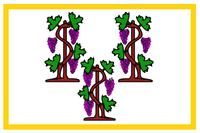



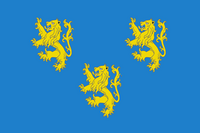


![Conn 2.png (46 KB) As a unifying design principle, I believe the flags of the original thirteen states should, when possible, incorporate thirteen stars. Above is my proposed design for a new flag for my home state. [Posted by Ken Morton]](https://static.wikia.nocookie.net/vexillology/images/4/41/Conn_2.png/revision/latest/scale-to-width-down/200?cb=20181114174312)
![Conn 2 copy.png (132 KB) Yet another 'Charter Oak' flag. This design builds upon earlier submissions by multiple users. [Posted by Ken Morton]](https://static.wikia.nocookie.net/vexillology/images/8/89/Conn_2_copy.png/revision/latest/scale-to-width-down/200?cb=20181121030504)
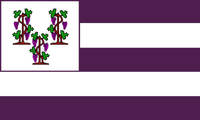


![Connecticut - Red Stars.png (57 KB) Connecticut state flag proposed by Ken Morton [June 26, 2019] I like this one.](https://static.wikia.nocookie.net/vexillology/images/1/10/Connecticut_-_Red_Stars.png/revision/latest/scale-to-width-down/200?cb=20190626145947)
![Screen Shot 2019-06-26 at 2.17.59 AM.png (68 KB) Yet another state flag for Connecticut. Really, anything would be better than our current flag. [Borrowed the grapes from "Bezbojnicul".] Posted by Ken Morton](https://static.wikia.nocookie.net/vexillology/images/5/50/Screen_Shot_2019-06-26_at_2.17.59_AM.png/revision/latest/scale-to-width-down/200?cb=20190626150303)
![Screen Shot 2019-06-26 at 7.12.32 PM.png (90 KB) Inspired by a design by "Sammy" [see above]. Posted by Ken Morton.](https://static.wikia.nocookie.net/vexillology/images/5/59/Screen_Shot_2019-06-26_at_7.12.32_PM.png/revision/latest/scale-to-width-down/200?cb=20190627000023)
![Connecticut - Fairfield County.png (269 KB) He who is transplanted, is sustained. [My home state] Posted by Ken Morton](https://static.wikia.nocookie.net/vexillology/images/a/a7/Connecticut_-_Fairfield_County.png/revision/latest/scale-to-width-down/200?cb=20191022032458)
![CT PNG.png (45 KB) The blue vertical line represents the Connecticut River (the longest in New England) cutting across the state, The three purple lines represent the grapevines in the state seal dating from 1635, as well as the original three colonial districts which united to form the state: Windsor, Wethersfield, and Hartford. The green bars run between the purple District bars and across the River bar, symbolizing the significance of the Charter Oak, which both helped unify and establish the state. The white backdrop represents the paper on which the US Constitution was written and the state’s nickname “Constitution State.” Posted by Preston Knapp [1]](https://static.wikia.nocookie.net/vexillology/images/f/f0/CT_PNG.png/revision/latest/scale-to-width-down/200?cb=20191027201821)






